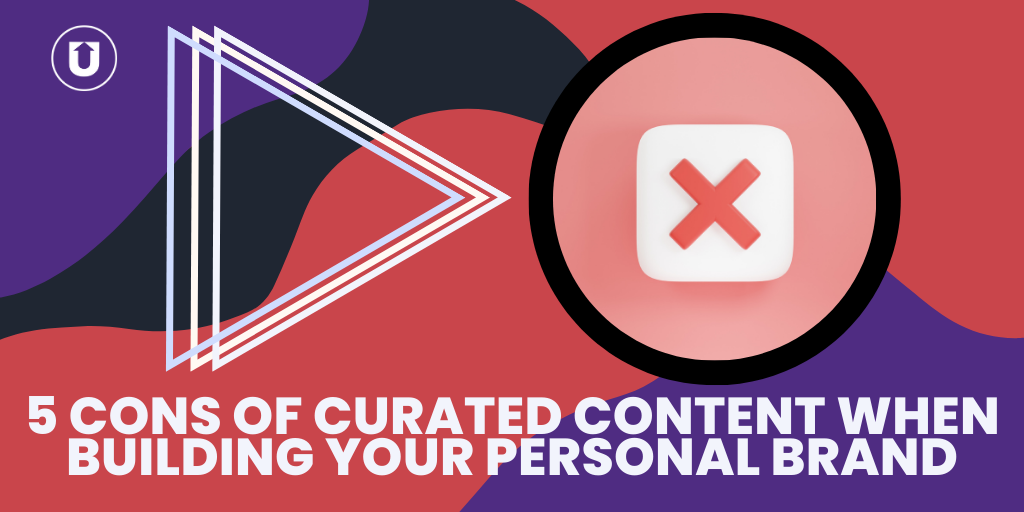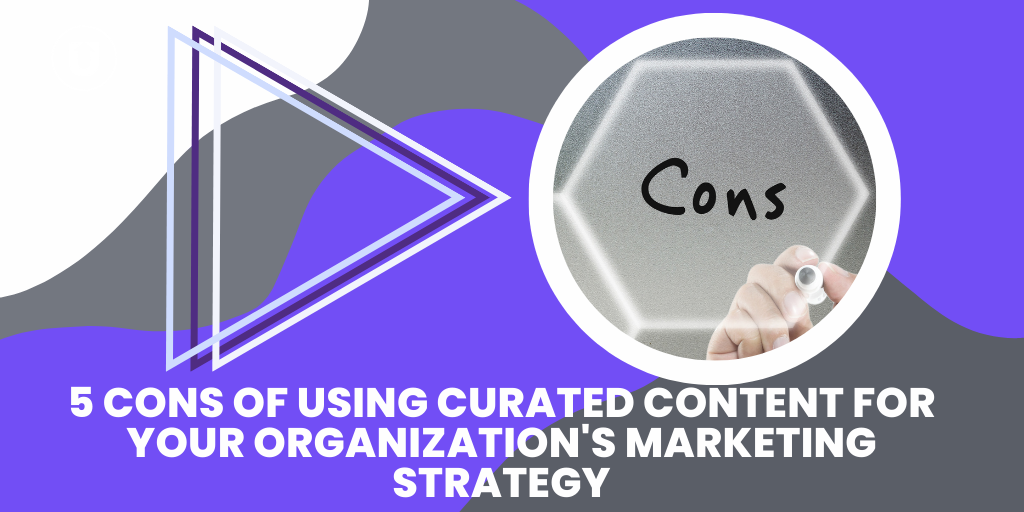5 Cons of Curated Content When Building Your Personal Brand

Are you looking for cons of curated content for your company’s marketing strategy? Check out this article.
Research suggests that when sharing a balanced mix of original and curated content, conversion rates are 10x higher than just sharing original content.
But as with any strategy, there are cons that must be dealt with if curation isn’t utilized with best practices in mind.
Here at UpContent, we help thousands of thought leaders build their personal brands by effectively leveraging curated content, and these are five of the biggest cons that should be considered when building your curation strategy for your personal brand.
Lack of Originality
One of the most significant drawbacks of using curated content is that the single article being shared intrinsically lacks originality.
When you’re sharing someone’s work as presented (i.e. without adding your original thoughts), you’re not sharing anything about yourself, what you think, and why you’re the expert.
That act of sharing tells your audience nothing more than, “I’ve shared something I found”, at best. At worst, you can be viewed as an individual merely adding noise to an already noisy world.
This lack of originality can also affect your ability to stand out in a crowded market. If you’re just sharing what someone else is doing with no context or reason why you’re sharing it, you can easily get lost in the online sea of content.
Solution for Lack of Originality
Be sure to add your own perspective as to what you take away from the piece being shared and why it is important (a "hot take" will do!), and be consistent in sharing valuable curated content.
It is through your consistency that you are able to tell a story about what you find interesting, value, and are following - all things your audience wishes to understand.
Curating content is akin to curating a museum exhibit.
It is extremely difficult for a single piece to tell the story, but when you bring together a number of pieces, you can learn something original about the museum's perspective - even if they didn't create the relics themselves.
If you only share curated content with no context, reason, or explanation for why you’re sharing third-party content, then you aren’t helping your audience believe that you are the thought leader you say you are.
A proper blend of created and curated content drives 2x the engagement overall and 10x the conversions on the original content you publish. If you’re mixing it up, you can still be original and curate content effectively.
Audience Feels Lied To
You know how in TV sitcoms there is a person who is having a dinner party and they want to impress their friends with how well they can cook?
Usually, this person has a reputation already, but they are trying to change that.
They go and buy the food from a restaurant, put it on plates, and make it seem as if they were the ones who actually cooked that food, but it usually comes out that, actually, the food is from some restaurant down the block.
That feeling of betrayal and feeling lied to is not one you want to impose on your audience, and it can happen if you are sharing third-party content without making it clear that the work isn’t yours.
Solution for Not Lying To Your Audience
The simplest solution is to make it absolutely clear you are sharing someone else’s work.
This is easier on social media and within email campaigns because you can share links directly to the original article, adding your thoughts and perspectives on the piece.
But when sharing that content on your website, you also must ensure that you are not duplicating the original work (even if you provide credit to the creator) and must instead use your own site as the exhibit hall and allow the reader to view the work in its own light (by taking them to the original work should they wish to read it in its entirely).
Don’t ever pretend that the work is your own. Instead, share the third-party content as a way to join in on the conversation and be a connector between your audience and good content.
Risk of Copyright Infringement
Using curated content without proper attribution or permission can lead to copyright infringement.
This can damage your reputation and potentially lead to legal issues.
While content curation is perfectly legal when done correctly, people get in trouble with the law because they are not curating but copying and publishing content as their own without proper attribution.
Just like in grade school, you can’t copy someone else’s answer and take credit as your own.
To avoid this, giving proper credit to the original author and seeking permission before using their content if you are republishing the whole piece on your platform is essential.
Sharing curated content can be a mutually beneficial practice when done correctly.
Solution For Curating Content Legally
Here at UpContent, we never advise copying and pasting someone’s work and publishing it elsewhere.
By providing sufficient context and linking to the original source, you can elevate the insights of the original piece to your audience.
This benefits you by positioning you as the one bringing these insights to your audience’s attention.
At the same time, the original author benefits from the increased traffic landing on their website as a result of the link.
Difficulty in Building Thought Leadership
If you’re only sharing curated content, you’re not demonstrating leadership.
Being a thought leader means you’re sharing your thoughts, not just everyone else’s.
It involves establishing yourself as a go-to resource for information and insights within your industry.
Curated content alone does not establish your brand as a thought leader since it relies on others’ ideas and perspectives.
Solutions For Building Yourself As A Thought Leader Using Curated Content
To establish thought leadership, both original and curated content is necessary.
There is no “one way” to succeed in content marketing anymore, and if you want to be a thought leader, you’re going to have to share some unique thoughts - but be sure also to show that these thoughts were incubated through constantly assessing and understanding the large context.
You can create your own content or add your thoughts and opinions to a curated article you are sharing.
Your thought leadership isn’t built just because you click the share button. It’s because you’re actually engaging and sharing high-value information - and “showing your work” in how you arrived at the conclusions you are espousing.
By sharing a mix of curated and original content, you demonstrate that you are aware of what’s happening in your industry and are willing to amplify others’ opinions while sharing your unique views.
Over-reliance On Curated Content
An over-reliance on curated content can quickly turn into a crutch to fill your content calendar.
While curated content can save time and effort, that should not be the main reason you use curated content.
Curated content should be used to supplement original content, not replace it.
Your audience wants to know what you think and how you can help them, not just see a collection of general, unrelated articles filling up their social feed or inbox.
It’s not wrong to share other people’s ideas or content, but you risk losing credibility when you’re not adding your perspective or the articles are seemingly selected at random.
Additionally, an over-reliance on curated content can create a lack of engagement with your audience.
When you curate content without adding anything, you’re not actively engaging and building relationships with your audience.
This can lead to a lack of trust and engagement, ultimately affecting your success.
Solutions For Over-relying On Curated Content
The most obvious solution would be to share original content to diversify the curated content you’re sharing, but if you’re in sales or building your personal brand not as a content creator, how exactly are you supposed to do this?
Chances are you don’t have time to create valuable content, or you don’t have a knack for writing, or you just don’t want to. Does this mean that you can’t use curated content either?
We have found that a mix of 60/40 or 70/30 curated/original content is a good recipe to start with!
Don’t let this number scare you though. Original content doesn’t have to always mean content that YOU are creating, especially if you work for a firm, a brokerage, or a company that is providing you with content you can share.
Mixing in company blogs, social media posts, and news articles will help you balance the third-party content and “original” thought content.
This will help you establish your brand voice, build thought leadership, and create deeper connections with your audience.
If company blogs aren’t an option for you, ensuring that you add you own opinions, thoughts, and reasons for sharing the curated article is key to demonstrating that you are the expert solution for your audience.
Your opinion and expertise are what will help you stand out in a crowded market,
Avoiding The 5 Big Cons Of Curated Content
All of these cons have a simple solution, which is don't exclusively to curate your content.
While curated content is an effective way to build credibility, it’s important not to rely too heavily on it.
As with everything marketing, balance and consistency are key.
Your audience wants to hear from you, not just see a collection of other people’s content, but they don’t want to hear from just you; they want to see that what you’re saying is supported by other experts.
If you’re interested in learning more about how curated content can be a great addition to your content marketing strategy, schedule a call today with one of our Content Curation Experts!
Or you can read more about content curation in one of these articles!
Five Benefits of Using Curated Content on Twitter for Thought Leadership
What’s the Difference Between Content Curation and Aggregation?



